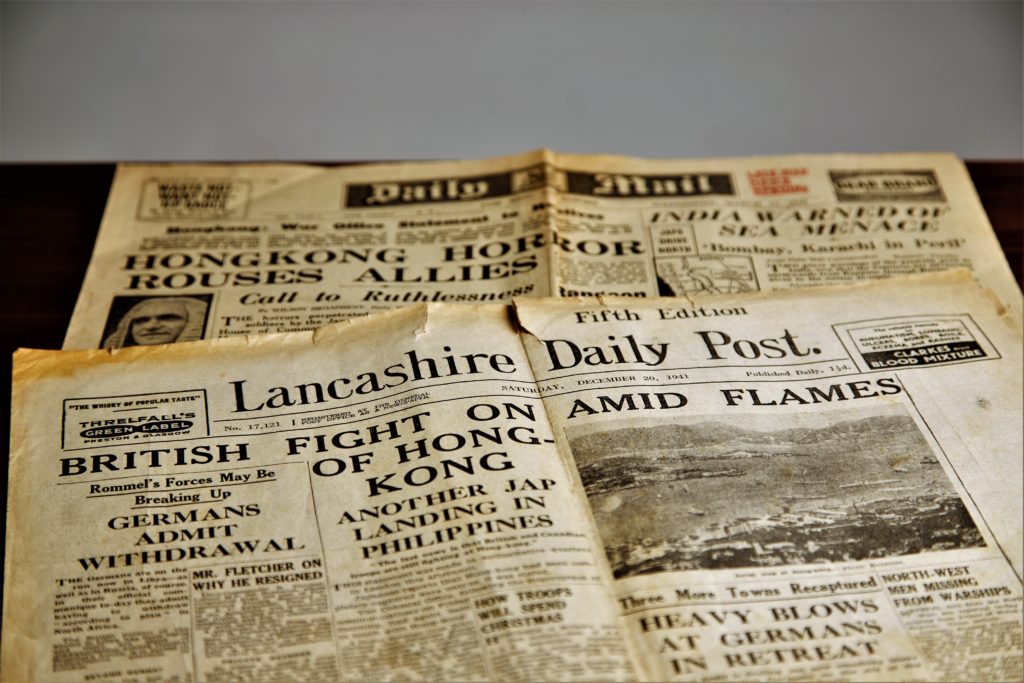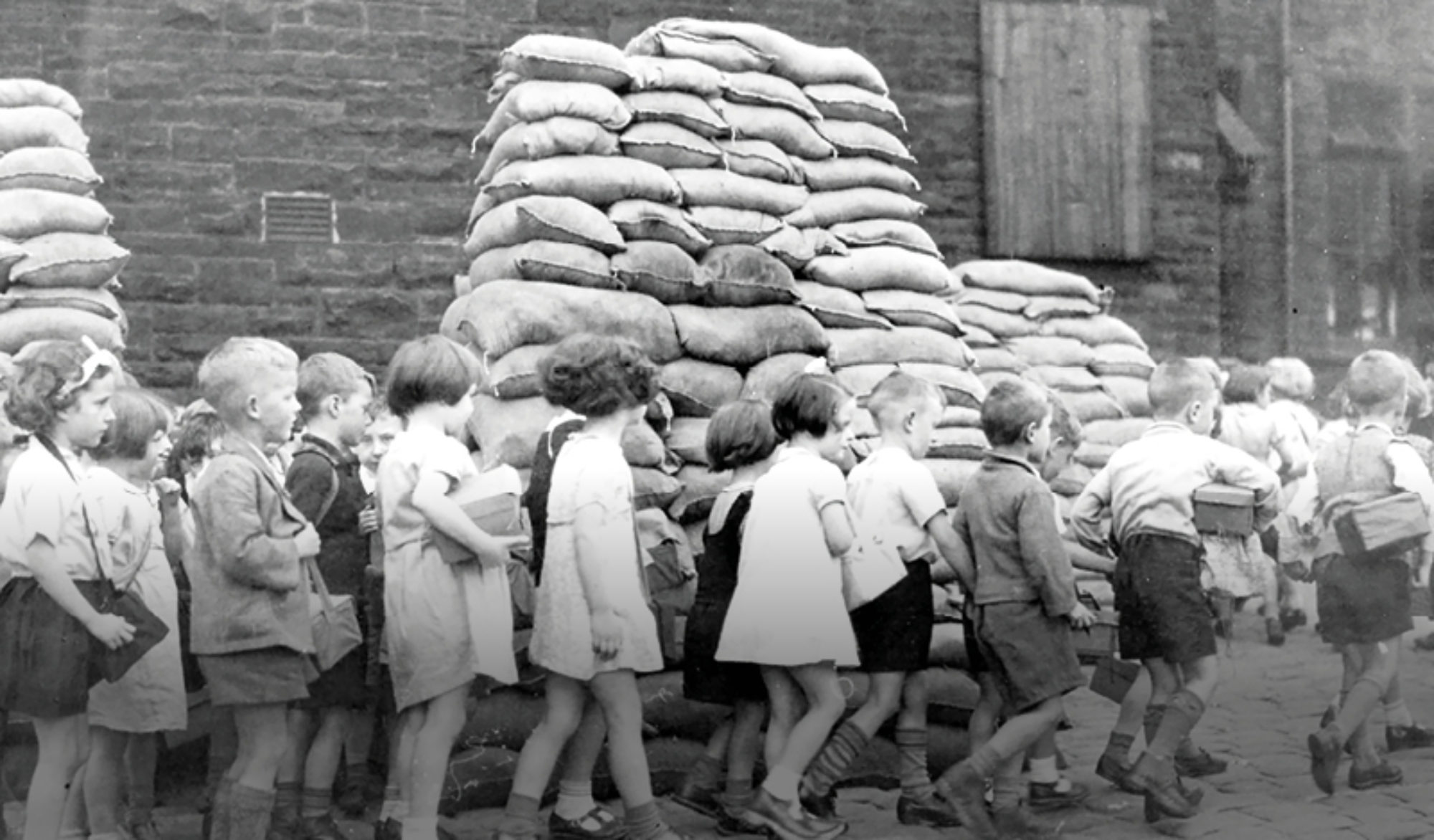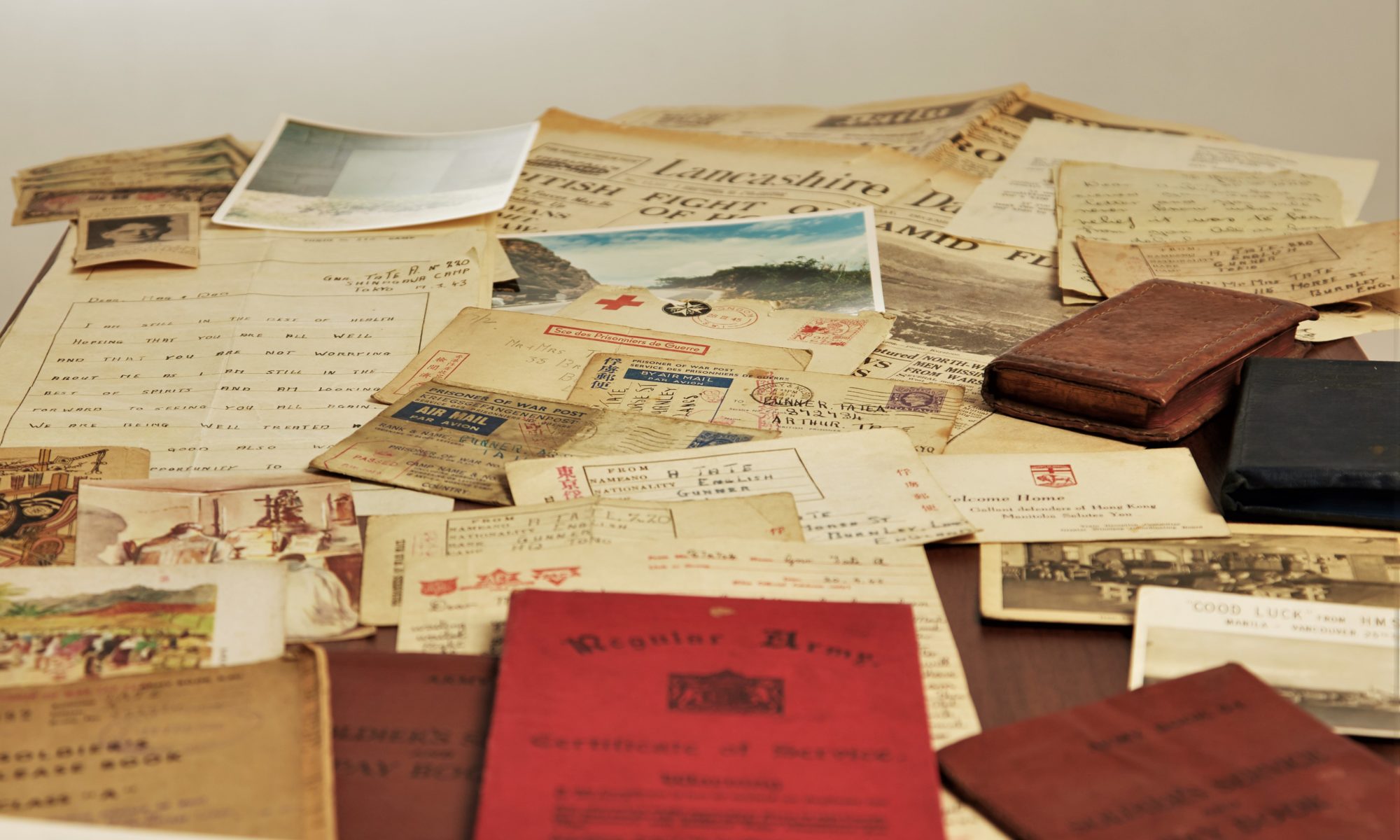Dr. Stephen Tate
March 2020
Welcome to the blog, Lest We Forget. As part of the WWII East Lancashire Childhoods project the blog aims to examine how family memorabilia combined with shared recollections can help foster a better understanding of the generation associated with World War Two.
A further aspect of this monthly feature will be a consideration of how historians use artefacts, the raw materials of their trade, to build a picture of past lives and societies. These can include the sort of objects some of us might come across in our own homes, from the official to the personal . . . even ephemera – material never designed to be saved or to have a lasting value, but which, by chance, carries with it a resonance of the past, an echo of other lives.
In addition, on a personal level, I want to use the blog to share my own experience of family memorabilia and World War Two. My late father, Arthur, served in the Royal Artillery as a teenager. He was taken prisoner when Hong Kong fell to the Japanese Army on Christmas Day, 1941, and endured almost four years as a prisoner of war in the Far East, he and his comrades used as slave labour in Japan’s heavy industries. He had joined up in Blackburn in late 1937, claiming to have turned 18, the minimum age for recruitment, a week earlier, when, in fact, he was still 15 and six weeks short of his 16th birthday. Desperate for adventure and to join older pals who had already signed up, family lore has it that it was his second attempt to escape Civvy Street as a 15-year-old!
Dad and his parents kept what might be termed now a small ‘archive’ of objects that stand testament to his and his comrades’ ordeal. There’s a brief local newspaper cutting of him being missing in action in the confusion of the colony’s fall. A series of brief letters home from captivity. Campaign medals. Service documents. A prayer book distributed on his First Communion which survived the war years with him, within which he wrote the names of friends, fellow prisoners of war, before they became separated upon liberation and repatriation. A further prayer book dropped on his prison camp by American Air Force transport planes in August, 1945, as the business of signalling the end of hostilities in Asia, and of finding, saving, and transporting Allied prisoners of war home began in earnest. Ephemera associated with that long journey home across the Pacific, then by rail across Canada and another ocean crossing, this time the Atlantic. There are gaps in my understanding of the small collection. At times a lack of context and information that robs me of a greater understanding. And this is an issue, a pitfall, I hope this blog will develop and help others avoid in their own attempts to better appreciate their own family’s World War Two associations.
For those of us aware of the fast-approaching VE Day 75th anniversary in May this year, there will surely be a realisation that whatever link we have with the World War Two generation is, unfortunately, fading. Many of us will have no, or very little, recollection of direct contact with family members, grandparents, perhaps, who lived through the war.
Maybe the forthcoming commemorations offer a fitting opportunity to reassess what we do know of our own family’s involvement in the war. A chance to dig out an old photograph, a newspaper cutting, letters, trinket box or ornament, a ration card, a postcard, the discarded wristwatch, a faded birth or marriage certificate, a battered and frayed favourite book of a grandparent, a commemorative coin or mug, a birthday or anniversary card, a piece of embroidery . . . Or perhaps, if we are lucky, a wartime diary, an Army pay book, certificate of service, record of discharge, a campaign medal, a souvenir of service or of a homecoming, a local newspaper obituary.
The chances of these objects’ survival are often slim, especially in our increasingly throw-away culture. They might be on the verge of that once-and-for-all domestic clear-out as the memory of their significance is finally lost or deemed too tenuous to justify house room. And if, on the last occasion, they managed to escape the clutter purge (just), what chance of their value being appreciated or hinted at for the next generation when, sadly, it’s their turn to weigh up what to keep and what to discard? It’s a common, if distressing, rite of passage. But it can be overcome and decisions made easier with a little foresight and planning.
If you are lucky enough to have material that links your family to one of the most momentous events of the Twentieth Century, then make time to write down what you know of it. Who you think it belonged to and why you think that. Jot down all you know of that person or that event and who told you about them or it. What was their relationship to the person connected with the object? What was their relationship to you? Provide as much detail as you can.
Not surprisingly, when we take time out to think about something, with a little focus and free of distractions, we often find we recall more than we originally thought possible. Perhaps there might be an opportunity to check your own impressions with those of a brother or sister, aunt or uncle, cousin, parent. Add their recollections, too. And, most importantly, keep the information and ideas you collect and jot down together with the object under consideration. Make sure they won’t become separated.
The History students I teach will confirm that a constant plea of mine when they are answering questions or planning assignments is that they add context to the topic they are considering. Nothing happens in a vacuum. A knowledge of what went before and what occurred at the time of the topic or event under review helps our understanding of it. It gives it added meaning. It helps us make sense of it. The time you take to mull over, discuss and write down your thoughts on the objects you find or rediscover, will provide your own context and help others interpret and enjoy them now and at a later date when the links in time are even more distant.
All is not lost, however, if you find yourself bereft of actual World War Two-era objects. What about a spot of oral history? Why not make time to chat to an elderly relative who has some childhood memories of the 1940s, or who can recall stories passed down to them by their own parents and elderly relatives? Saving those for posterity, either as an audio recording or as handwritten notes could be an enjoyable experience. Something for the family as a whole to combine in and enjoy. This is a particular idea I will develop further in a later blog.
By the way, as the blog develops I will be keeping an eye open for other internet sites, museum exhibitions and archive events touching on family memorabilia, World War Two remembrance and the nature of History and will, where appropriate, provide links to, and information about, them.

Rather ironically, the material I have chosen to illustrate this opening blog (above) is not from my late father’s ‘archive’. I decided to use a couple of newspaper editions acquired by me a few years ago to help provide that vital research ingredient, context. They are newspapers – the Lancashire Daily Post, December 20, 1941, and the Daily Mail of March 11, 1942 – printed as the Hong Kong garrison made its last stand, and then after a few months of troop internment. They are of their time – written in the uncompromising and bruising language of war. They were read at breakfast tables and in works canteens across Britain. They would have been read by my grandparents as they awaited news of their son, the man who would become my father. They provide a sense, however limited, of the psychological horrors they, too endured in time of war.
In later postings I will be returning to the themes raised in this opening blog, suggesting further ideas, considering how both professional historians and family enthusiasts tackle the job of recording the past. But before closing, I would like to pose a question or, if you like, set a challenge to the readers of this blog!
What’s stopping you checking what you might have in the house that provides a link with the wartime years? Why not have a root around? It’s good to talk. Start a family chat. Who knows what you might turn up, what surprises a relative might deliver up?
I’ll call an end to this first blog (hoping it has provided food for thought) with one of my favourite quotes on the nature of History. It’s by Jonathan Clark, in his book Our Shadowed Present (London: Atlantic Books), 2003, p.13. It considers the place of the past in the present. The way our lives and expectations are governed by what has gone before. You may or may not agree with the sentiment, and it took me a few readings before, I think, the concept sank home, but its eloquence is undeniable and, for me at least, it seems a fitting spur to reflection on the topic of this opening blog.
‘The future is a blank, the present a fleeting moment in which we cannot stay. We live in the past, and our only choice is between alternative pasts which might supply our mental furniture. We walk backwards into an unknowable future, and what distinguishes us is only whether we are myopic or long-sighted as we do so. What makes the future recognizable as we enter it is nothing substantive in the idea of “the future” itself, which recedes continually beyond our grasp, but rather the continuities in ourselves and our contemporaries, continuities established by our historical sense. To look forward, to display foresight, to show prudence is not to penetrate the future, for the future is and must always remain to us a featureless silence; it is to reflect intelligently on the past, and to understand what lessons can and cannot be learned from it.’ – Jonathan Clark, Our Shadowed Present. Modernism, Postmodernism and History (London: Atlantic Books), 2003, p.13

